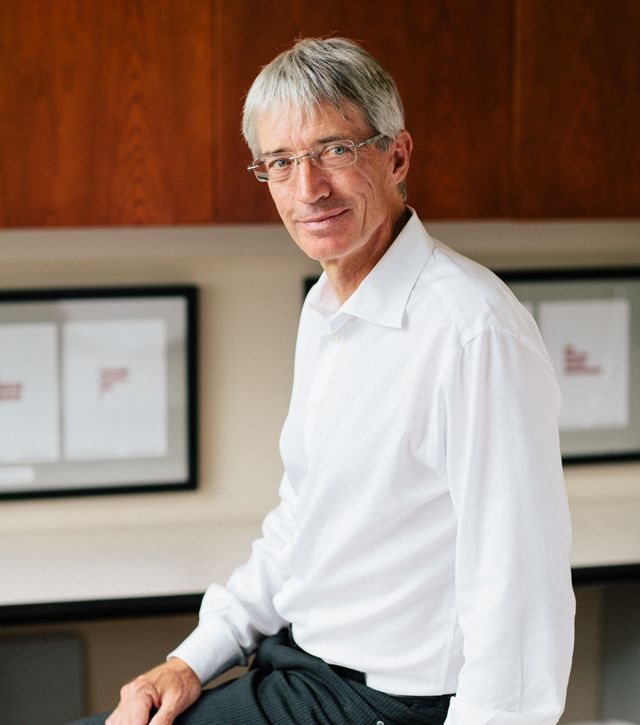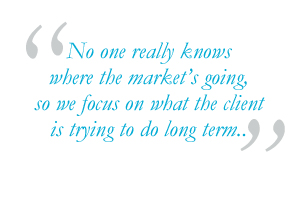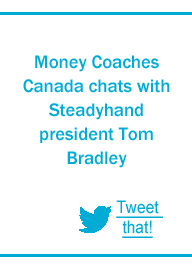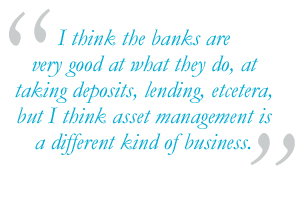
Tom Bradley, President and co-founder of Steadyhand Investment Management Ltd.
Money Coach Noel D’Souza, P.Eng.,CFP® recently sat down with Tom Bradley, President and co-founder of Steadyhand Investment Management Ltd. to talk about what Steadyhand offers Canadian investors how it serves its clients and his perspective on personal finance in Canada.
In addition to Tom Bradley’s leadership at Steadyhand, he selects and monitors Steadyhand fund managers and manages the firm’s Founders Fund. He has over 30 years of experience in the investment industry, including senior leadership roles at other well-known investment management firms. He currently serves as the Chairperson of the Investment Committee of the Vancouver Foundation.
Noel: Tom, who would you say is Steadyhand’s typical client and what services does Steadyhand offer?
Tom: We have a wide variety of clients, but I’d have to say that the bulk of our clients are what we call midlife professionals, in their forties and fifties, busy with kids and careers and the stuff of life. Very smart people who just don’t have the time, interest, or maybe knowledge, on the investment side of their finances, and so they look to us to do that for them.
 We also have an increasing number of young clients. Our low minimums, which are ten thousand per fund, have opened that door. But of course we also have many retired clients as well.
We also have an increasing number of young clients. Our low minimums, which are ten thousand per fund, have opened that door. But of course we also have many retired clients as well.
Our average client portfolio is around $275 000, but we have many clients under $100,000. We offer them investment management and we offer investment advice, not holistic financial planning.
Noel: I think that’s one of the reasons why Steadyhand’s work resonates with what we do at Money Coaches Canada, and why we work well together; we also typically serve busy mid-to-late career professionals, but we provide that holistic financial planning element.
What would you say is the single greatest benefit that a client will experience when working with Steadyhand?
Tom: I’d say that the single greatest thing we do for our clients is right in our name; we do a very good job of providing a steady hand. Dealing with the ups and downs of the market is crucial to long term returns. We keep people on track. We’ve looked at the data and our clients are letting the power of compounding, which Einstein calls the eighth wonder of the world, work for them in growing their assets over time.
We’re all living longer. We want people to think ahead to what I call the last third of their lives, which is going to start somewhere in their sixties and could very well go into their nineties. We need to get people to think ahead to that last third.
Noel: What do you find is the most frequent question or concern raised by new clients, and how do you respond to it?
Tom: One question that would be in the top three or four is: do I have enough? But we leave that one to Money Coaches and other financial planners to answer, because that’s a more complicated one. But another question that comes up a lot is: is it a good time to invest?
There’s always somebody in the media saying the market’s going to go down or up or whatever, and what we really try and reinforce with clients is that we don’t know where the market’s going. We don’t make one, two or three year predictions. We share our view of what five year returns are going to be like, but no one really knows where the market’s going, so we focus on what the client is trying to do in the long term with this portfolio. So we generally answer that question with: it’s always a good time to invest.
 I’ve made the point to people that fear is not an equal opportunity emotion in investing. Volatility means something different to a retired person drawing on their portfolio for income, than it does to someone who is still an “accumulator” – people that have a little longer timeframe for investing, who are putting money in, making RRSP contributions, that sort of thing.
I’ve made the point to people that fear is not an equal opportunity emotion in investing. Volatility means something different to a retired person drawing on their portfolio for income, than it does to someone who is still an “accumulator” – people that have a little longer timeframe for investing, who are putting money in, making RRSP contributions, that sort of thing.
The retired person doesn’t want to take money out when markets are down and they have to arrange their affairs accordingly. But for accumulators, people that are building their portfolio, volatility and weak markets, while they’re a little distressing at times, are a wonderful opportunity.
Noel: Right, and that’s the point that you raised earlier about being a steady hand that keeps people on track, because although volatility presents an opportunity for accumulators, it doesn’t often feel that way when they’re in the middle of a market downturn.
You also mentioned the difference in needs for accumulators, versus those who are at or approaching retirement. So when a client hires your firm, what should they expect and what do you think is different or unique about Steadyhand?
Tom: Steadyhand is focused on producing higher client returns in a simpler, more human experience. We have experienced professionals that are totally aligned with our clients. 89% of their financial assets on average are invested in the same funds as our clients. As you know, we published what we call the eating our own cooking number, or co-investment – we have way better transparency than almost anybody on the street. So clients know their returns, their fees, what we’ve done well, what mistakes we’ve made.
I think one of the things that our clients feel, is that we’re not a bank. I think we have a personality and are personable, and that people can really relate to what we’re doing.
Noel: Could you talk a little bit more about how Steadyhand charges for your services? How do the fees work?
Tom: Clients pay us through a fee that comes out of the mutual funds that we use to build our clients’ portfolios. So it’s called an MER or a Management Expense Ratio, which is how we get paid and we pay the managers who run the fund, etcetera.
 So for example, our Founders Fund, which is our overall sort of diversified fund, has a MER or total fee, including taxes and everything, of 1.34%, and so a client that owns the Founders Fund, that’s how they pay us.
So for example, our Founders Fund, which is our overall sort of diversified fund, has a MER or total fee, including taxes and everything, of 1.34%, and so a client that owns the Founders Fund, that’s how they pay us.
The thing about us though, is that as your assets grow or you put more money with us, and once you go north of $100 000, our fee starts to taper down lower. And so from a $100,000 to $250,000, the fee is 20% lower; from $250,000 to $500,000 it’s 30% lower. And then any assets over half a million dollars, it’s 40% below, in this case, 1.34%.
So clients that have a few hundred thousand dollars would start to see a real impact as their fees come down with that fee reduction related to the size of their account.
The other thing we do – and it’s very unique – is that we reward loyalty. So for somebody who’s been with us for five years, we reduce their fee by 7% and we’re just about a year away from our ten year anniversary, when we’ll start to have some clients who will benefit from being ten year clients, and we’ll see their fee come down another 7%.
So fees are low, they come out of the funds. There are no other charges, no nickel and diming. Taxes are included and they’re all reported in the statements. And as people grow with us and stay with us, the fees come down over time.
Noel: You are often a guest columnist for The Globe and Mail newspaper and MoneySense magazine, contributing your thoughts about the state of the financial industry and where you see it going, or where you see it needing to go.
When you think about the state of personal finance in Canada, what concerns you the most, and why?
Tom: I’d say there are two things, and the first one will seem a little hard-hitting, but I think that bankification of the asset management business is concerning to me. I think the banks are very good at what they do, at taking deposits, lending, etcetera, but I think asset management is a different kind of business. The big institutions are very driven by the profit motive, as we all are in the business, but I think too often decisions are made miles from the frontlines in an office tower on Bay Street, and they’re not always client-friendly decisions.
 The second thing that concerns me is people’s inability to take risk. There are some staggering statistics out there that show what percentage of Canadians’ financial assets, are actually just in cash-like instruments. Black Rock did a study and I think the number was 62%. It sounds outrageous, but I think if you include GICs, which is effectively a savings vehicle, not an investment vehicle, the number might be that high. We had the crash after the tech bubble; we had the ’08 crash and then lots of volatility since and I think Canadians have forgotten how to take risks and that’s a real downer as far as the state of personal finance in Canada.
The second thing that concerns me is people’s inability to take risk. There are some staggering statistics out there that show what percentage of Canadians’ financial assets, are actually just in cash-like instruments. Black Rock did a study and I think the number was 62%. It sounds outrageous, but I think if you include GICs, which is effectively a savings vehicle, not an investment vehicle, the number might be that high. We had the crash after the tech bubble; we had the ’08 crash and then lots of volatility since and I think Canadians have forgotten how to take risks and that’s a real downer as far as the state of personal finance in Canada.
Noel: What do you think needs to happen to prompt people to put these languishing assets to work?
Tom: That’s a great question. There are new regulations in financial reporting coming by the end of this year that will require dealers to show clients how they’ve done, as well as disclosing fees. If the portfolio has been reasonably invested, people will begin to see that despite all the ups and downs, those returns are better than GICs and money in the bank. That will be a step in the right direction, but I think it will be a long process.
Noel: For sure. At Money Coaches Canada we encourage people to put a financial plan in place so they understand how much risk is appropriate for them to take, to reach their very specific and personal financial goals, whether that be retirement or travel or funding their kids’ education, or whatever the case may be. Once they have a plan they can reasonably decide what’s an appropriate amount to have in cash, and what, quite frankly, is too much and leaves a lot of assets sitting idle.
What do you think will be the biggest change Canadians will experience in the next few years, related to personal finance?
Tom: I think the biggest change will be to the 35 year trend of declining interest rates. It has been maybe the greatest bull market of all time. Everybody’s got a story from the eighties about a Canada Savings Bond they had, or a mortgage they took out at 18%, and today we’ve gotten near zero interest rates.
When I say bull market, I mean bull market in fixed income and bonds specifically. So as we go forward, maybe rates can stay near zero for a number of years, it’s hard to predict. But over time you either have almost no return from fixed income, or rates start to rise and returns out of people’s fixed income portions of their portfolio could even be negative for a few years.
Steadily declining interest rates have been a wonderful tail-wind for the stable, secure fixed income part of your portfolio and has produced almost equity-like returns year after year with very few exceptions.
So I think the biggest change will be getting our clients to understand that they are going to have to own more equities and accept more volatility than, for instance, a retired investor might have had a decade or two ago.
Noel: And sort of dovetailing with that, people are living longer, which is a good thing in most cases, except when you talk about longevity and the potential for outliving your assets. So perhaps that change to a larger equity holding is also appropriate, if they’re going to have to fund, as you said, the last third of their life.
Tom: Exactly
Noel: Thank you Tom, for sharing your insights with our readers. We look forward to more from Steadyhand on your blog, in your contributions in the Globe and Mail and MoneySense, and in all the other things you do to help move the industry forward.
Tom: Thanks for your interest Noel. I always enjoy working with the Money Coaches Canada and we’ll continue to do that going forward.
For more information about Tom Bradley or Steadyhand Investment Management Ltd., you can visit their website at www.steadyhand.com
